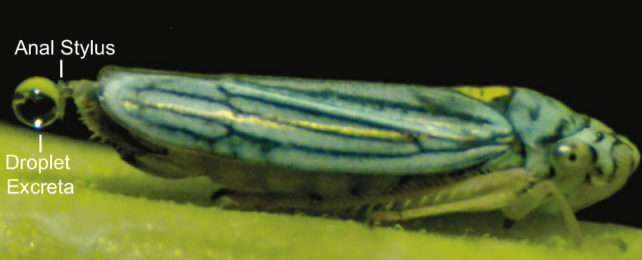A new study outlines an incredible feat of projectile peeing discovered in an insect named for its quick-draw delivery of waste.
The tiny glassy-winged sharpshooter (Homalodisca vitripennis) is able to urinate at a velocity that's staggering for its 12 millimeter (half inch) body, flinging a bead of liquid at speeds of around 30 centimeters per second.
Based on a detailed analysis involving computer modeling and physical experiments, scientists think that the unusual way that these insects pee helps them conserve the precious little energy they absorb from the nutrient-poor plant fluids they feed from.
The research was sparked by observations made by Saad Bhamla, a biomolecular engineer from Georgia Institute of Technology in the US, who noticed the sharpshooter's peeing behavior in his backyard.
The insects excrete tiny droplets of pee from their rear ends, shooting them off at high speeds with the help of a stylus appendage that acts like a catapult.
"Little is known about the fluid dynamics of excretion, despite its impact on the morphology, energetics, and behavior of animals," says Bhamla.
"We wanted to see if this tiny insect had come up with any clever engineering or physics innovations in order to pee this way."
With high-speed cameras and microscopy techniques, Bhamla and his colleagues took a closer look at this blink-and-you'll-miss-it, catapult-style urination. The stylus acts a little like the flipper on a pinball machine, accelerating the pee drops at more than 40Gs (a whole 10 times higher than top-end sports cars).
It was when they compared the speed of the stylus flick with the speed of the droplets that the scientists noticed evidence of superpropulsion. The drops can travel at speeds 1.4 times that of the stylus, implying an additional source of force.
The scientists determined the stylus compressed the liquid drops before release, storing energy in the surface tension and elasticity between the droplets' molecules. Timed just right, the launch can send the pee flying off at super speed.
"We realized that this insect had effectively evolved a spring and lever like a catapult and that it could use those tools to hurl droplets of pee repeatedly at high accelerations," says Elio Challita, a biomolecular engineering student also from the Georgia Institute of Technology.
The final question was why the sharpshooters had evolved in this way. Through an analysis of sharpshooters' morphology, hindgut, and the fluid dynamics of xylem sap within it, the scientists think this energy-efficient method lets the insects expel relatively large amounts of fluid more easily.
At 95 percent water, xylem sap contains few nutrients, so sharpshooters need to drink huge volumes of it – up to 300 times their body weight each day – to get enough energy to survive. While other insects use jets of pee to get rid of the watery waste they generate, that's not the case with H. vitripennis – their small bodies need a less demanding method of expulsion.
What's more, the researchers think the way sharpshooters fling droplets large distances could also help them escape detection from predators, which may be attracted to chemical cues in urine.
The team compares it to trying to throw "a beach ball-sized globe of maple syrup" off a human hand – not an easy task. It's a fascinating look at how these bugs have evolved to pee in the most efficient and effective way possible.
It's the first time this kind of superpropulsion has been seen in a living animal. Eventually, these findings could help us figure out better ways of expelling water from low-power gadgets such as smartwatches, the researchers say.
"This work reinforces the idea of curiosity-driven science being valuable," says Challita.
"And the fact that we discovered something that is so interesting – superpropulsion of droplets in a biological system and heroic feats of physics that have applications in other fields – makes it even more fascinating."
The research has been published in Nature Communications.
